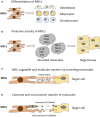Adipose, Bone Marrow and Synovial Joint-Derived Mesenchymal Stem Cells for Cartilage Repair
- PMID: 28066501
- PMCID: PMC5167763
- DOI: 10.3389/fgene.2016.00213
Adipose, Bone Marrow and Synovial Joint-Derived Mesenchymal Stem Cells for Cartilage Repair
Abstract
Current cell-based repair strategies have proven unsuccessful for treating cartilage defects and osteoarthritic lesions, consequently advances in innovative therapeutics are required and mesenchymal stem cell-based (MSC) therapies are an expanding area of investigation. MSCs are capable of differentiating into multiple cell lineages and exerting paracrine effects. Due to their easy isolation, expansion, and low immunogenicity, MSCs are an attractive option for regenerative medicine for joint repair. Recent studies have identified several MSC tissue reservoirs including in adipose tissue, bone marrow, cartilage, periosteum, and muscle. MSCs isolated from these discrete tissue niches exhibit distinct biological activities, and have enhanced regenerative potentials for different tissue types. Each MSC type has advantages and disadvantages for cartilage repair and their use in a clinical setting is a balance between expediency and effectiveness. In this review we explore the challenges associated with cartilage repair and regeneration using MSC-based cell therapies and provide an overview of phenotype, biological activities, and functional properties for each MSC population. This paper also specifically explores the therapeutic potential of each type of MSC, particularly focusing on which cells are capable of producing stratified hyaline-like articular cartilage regeneration. Finally we highlight areas for future investigation. Given that patients present with a variety of problems it is unlikely that cartilage regeneration will be a simple "one size fits all," but more likely an array of solutions that need to be applied systematically to achieve regeneration of a biomechanically competent repair tissue.
Keywords: Mesenchymal stem cell (MSC); adipose tissue; articular cartilage; bone marrow; synovial joint; tissue engineering.
Figures




Similar articles
-
Mesenchymal stem cells in regenerative medicine: Focus on articular cartilage and intervertebral disc regeneration.Methods. 2016 Apr 15;99:69-80. doi: 10.1016/j.ymeth.2015.09.015. Epub 2015 Sep 15. Methods. 2016. PMID: 26384579 Review.
-
Evaluation of the Safety and Regenerative Potential of Human Mesenchymal Stem Cells and Their Extracellular Vesicles in a Transgenic Pig Model of Cartilage-Bone Injury In Vivo - Preclinical Study.Stem Cell Rev Rep. 2025 May;21(4):1075-1095. doi: 10.1007/s12015-025-10853-4. Epub 2025 May 17. Stem Cell Rev Rep. 2025. PMID: 40380984 Free PMC article.
-
Treatment of osteochondral defects in the rabbit's knee joint by implantation of allogeneic mesenchymal stem cells in fibrin clots.J Vis Exp. 2013 May 21;(75):e4423. doi: 10.3791/4423. J Vis Exp. 2013. PMID: 23728213 Free PMC article.
-
Cartilage regeneration using arthroscopic flushing fluid-derived mesenchymal stem cells encapsulated in a one-step rapid cross-linked hydrogel.Acta Biomater. 2018 Oct 1;79:202-215. doi: 10.1016/j.actbio.2018.08.029. Epub 2018 Aug 28. Acta Biomater. 2018. PMID: 30165202 Free PMC article.
-
Harnessing knee joint resident mesenchymal stem cells in cartilage tissue engineering.Acta Biomater. 2023 Sep 15;168:372-387. doi: 10.1016/j.actbio.2023.07.024. Epub 2023 Jul 21. Acta Biomater. 2023. PMID: 37481194 Review.
Cited by
-
Current and future uses of skeletal stem cells for bone regeneration.World J Stem Cells. 2020 May 26;12(5):339-350. doi: 10.4252/wjsc.v12.i5.339. World J Stem Cells. 2020. PMID: 32547682 Free PMC article. Review.
-
Mesenchymal stem cell-mediated transfer of mitochondria: mechanisms and functional impact.Cell Mol Life Sci. 2022 Mar 5;79(3):177. doi: 10.1007/s00018-022-04207-3. Cell Mol Life Sci. 2022. PMID: 35247083 Free PMC article. Review.
-
Effect of Chitosan Nanoparticle-Loaded Thymus serpyllum on Hydrogen Peroxide-Induced Bone Marrow Stromal Cell Damage.Stem Cells Int. 2019 Feb 26;2019:5142518. doi: 10.1155/2019/5142518. eCollection 2019. Stem Cells Int. 2019. PMID: 30956670 Free PMC article.
-
VEGF/VEGF-R/RUNX2 Upregulation in Human Periodontal Ligament Stem Cells Seeded on Dual Acid Etched Titanium Disk.Materials (Basel). 2020 Feb 5;13(3):706. doi: 10.3390/ma13030706. Materials (Basel). 2020. PMID: 32033260 Free PMC article.
-
Cartilage Organoids from Articular Chondroprogenitor Cells and Their Potential to Produce Neo-Hyaline Cartilage.Cartilage. 2025 Feb 10:19476035241313179. doi: 10.1177/19476035241313179. Online ahead of print. Cartilage. 2025. PMID: 39925233 Free PMC article.
References
-
- Adachi N., Sato K., Usas A., Fu F. H., Ochi M., Han C. W., et al. . (2002). Muscle derived, cell based ex vivo gene therapy for treatment of full thickness articular cartilage defects. J. Rheumatol. 29, 1920–1930. - PubMed
Publication types
Grants and funding
LinkOut - more resources
Full Text Sources
Other Literature Sources
Medical

